McDonald's NZ Business Strategy: Environment & Sustainability Report
VerifiedAdded on 2023/06/05
|24
|6103
|168
Report
AI Summary
This report assesses McDonald’s business strategy, environment, and sustainability in New Zealand. It examines internal and external environmental factors using PESTLE and VRIO analyses. The report details McDonald’s strategic hierarchy, key success factors, and strategic challenges. It explores strategic options, CSR initiatives, and environmental management practices. The analysis includes recommendations for managerial actions and organizational strategy, focusing on HRM and aligning with the external and internal environment of New Zealand. The report concludes by examining McDonald's communication strategies and providing insights into achieving a competitive advantage in the New Zealand market. Desklib provides access to this document and many other solved assignments for students.
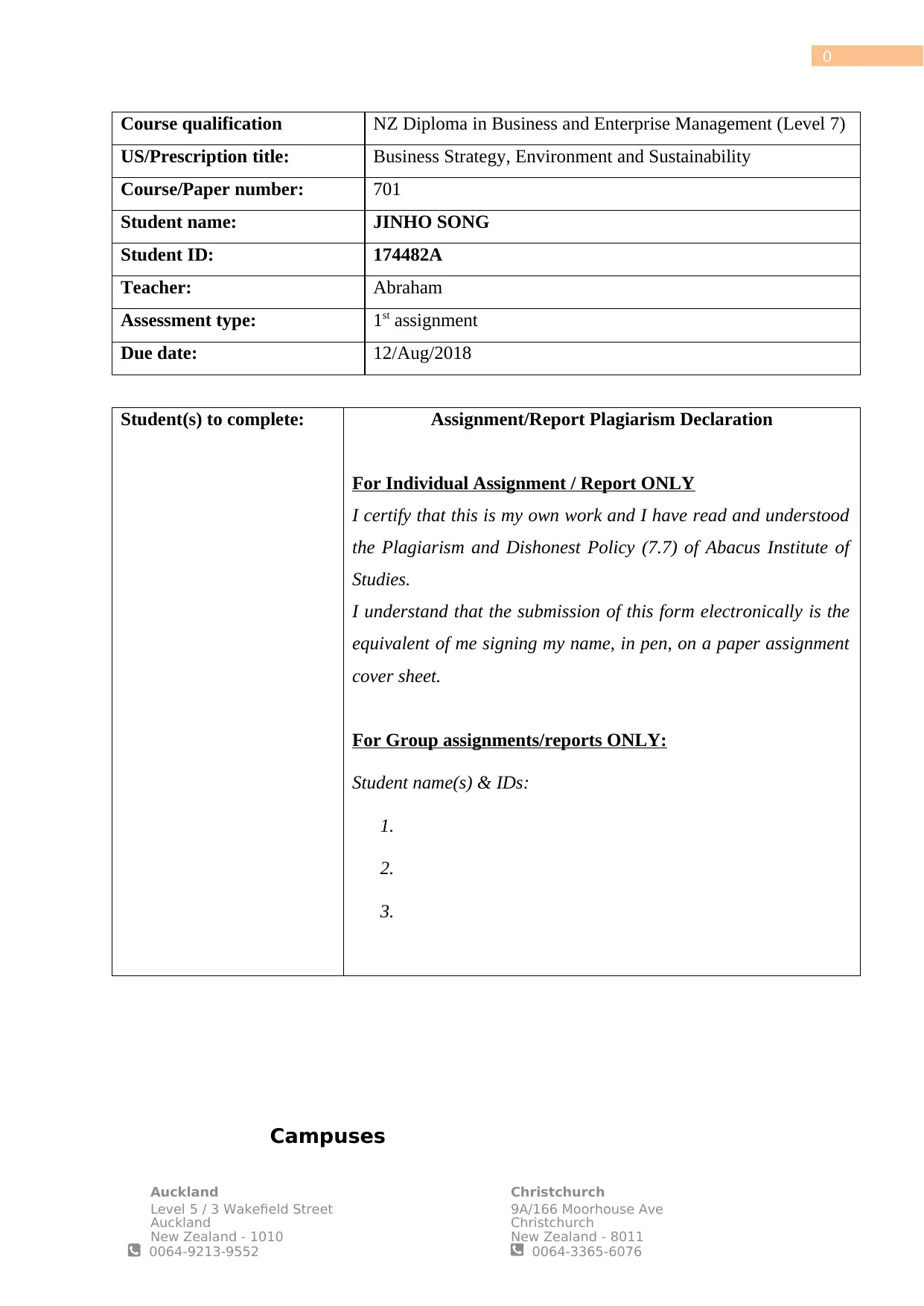
0
Course qualification NZ Diploma in Business and Enterprise Management (Level 7)
US/Prescription title: Business Strategy, Environment and Sustainability
Course/Paper number: 701
Student name: JINHO SONG
Student ID: 174482A
Teacher: Abraham
Assessment type: 1st assignment
Due date: 12/Aug/2018
Student(s) to complete: Assignment/Report Plagiarism Declaration
For Individual Assignment / Report ONLY
I certify that this is my own work and I have read and understood
the Plagiarism and Dishonest Policy (7.7) of Abacus Institute of
Studies.
I understand that the submission of this form electronically is the
equivalent of me signing my name, in pen, on a paper assignment
cover sheet.
For Group assignments/reports ONLY:
Student name(s) & IDs:
1.
2.
3.
Campuses
Auckland
Level 5 / 3 Wakefield Street
Auckland
New Zealand - 1010
0064-9213-9552
Christchurch
9A/166 Moorhouse Ave
Christchurch
New Zealand - 8011
0064-3365-6076
Course qualification NZ Diploma in Business and Enterprise Management (Level 7)
US/Prescription title: Business Strategy, Environment and Sustainability
Course/Paper number: 701
Student name: JINHO SONG
Student ID: 174482A
Teacher: Abraham
Assessment type: 1st assignment
Due date: 12/Aug/2018
Student(s) to complete: Assignment/Report Plagiarism Declaration
For Individual Assignment / Report ONLY
I certify that this is my own work and I have read and understood
the Plagiarism and Dishonest Policy (7.7) of Abacus Institute of
Studies.
I understand that the submission of this form electronically is the
equivalent of me signing my name, in pen, on a paper assignment
cover sheet.
For Group assignments/reports ONLY:
Student name(s) & IDs:
1.
2.
3.
Campuses
Auckland
Level 5 / 3 Wakefield Street
Auckland
New Zealand - 1010
0064-9213-9552
Christchurch
9A/166 Moorhouse Ave
Christchurch
New Zealand - 8011
0064-3365-6076
Paraphrase This Document
Need a fresh take? Get an instant paraphrase of this document with our AI Paraphraser
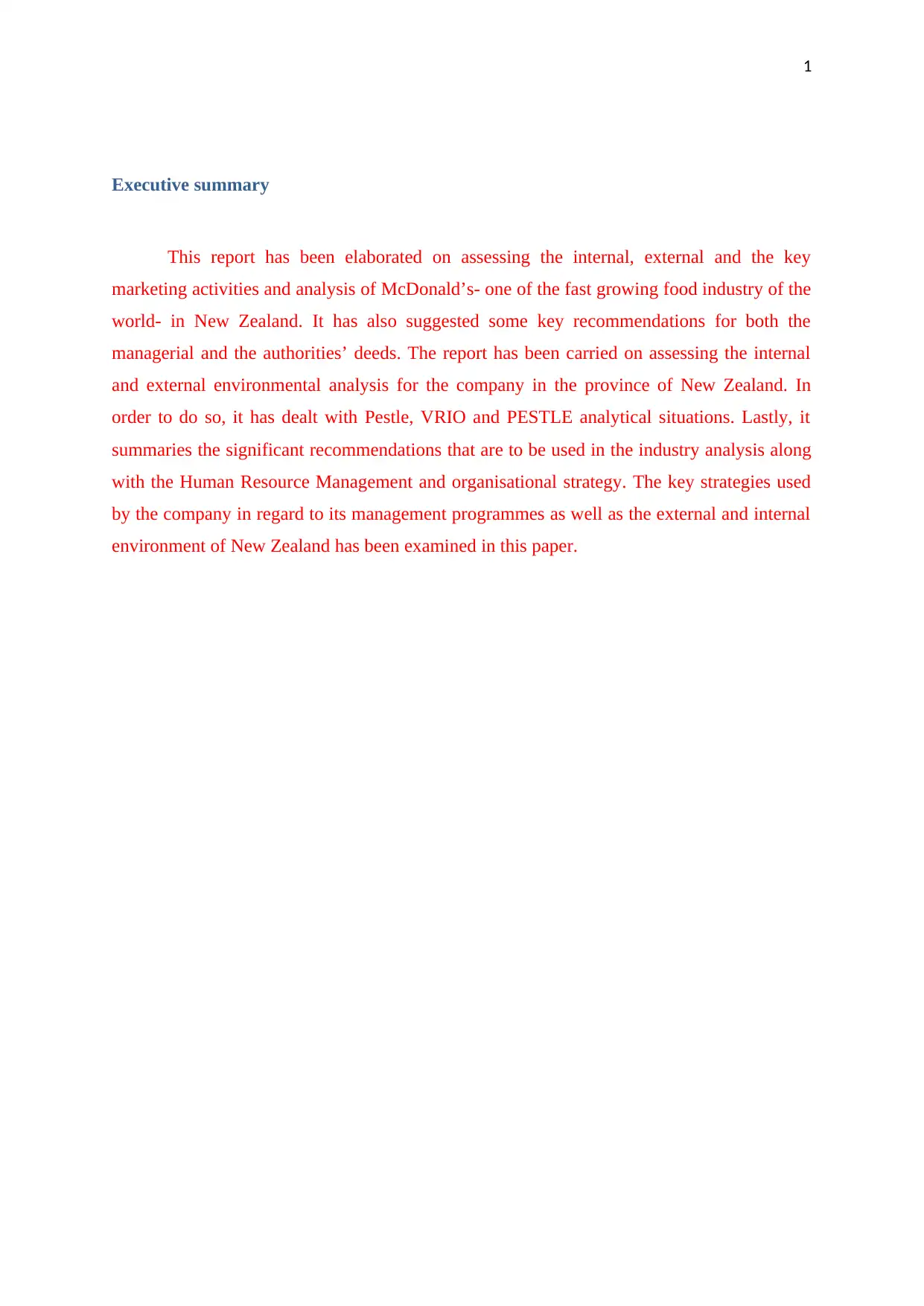
1
Executive summary
This report has been elaborated on assessing the internal, external and the key
marketing activities and analysis of McDonald’s- one of the fast growing food industry of the
world- in New Zealand. It has also suggested some key recommendations for both the
managerial and the authorities’ deeds. The report has been carried on assessing the internal
and external environmental analysis for the company in the province of New Zealand. In
order to do so, it has dealt with Pestle, VRIO and PESTLE analytical situations. Lastly, it
summaries the significant recommendations that are to be used in the industry analysis along
with the Human Resource Management and organisational strategy. The key strategies used
by the company in regard to its management programmes as well as the external and internal
environment of New Zealand has been examined in this paper.
Executive summary
This report has been elaborated on assessing the internal, external and the key
marketing activities and analysis of McDonald’s- one of the fast growing food industry of the
world- in New Zealand. It has also suggested some key recommendations for both the
managerial and the authorities’ deeds. The report has been carried on assessing the internal
and external environmental analysis for the company in the province of New Zealand. In
order to do so, it has dealt with Pestle, VRIO and PESTLE analytical situations. Lastly, it
summaries the significant recommendations that are to be used in the industry analysis along
with the Human Resource Management and organisational strategy. The key strategies used
by the company in regard to its management programmes as well as the external and internal
environment of New Zealand has been examined in this paper.
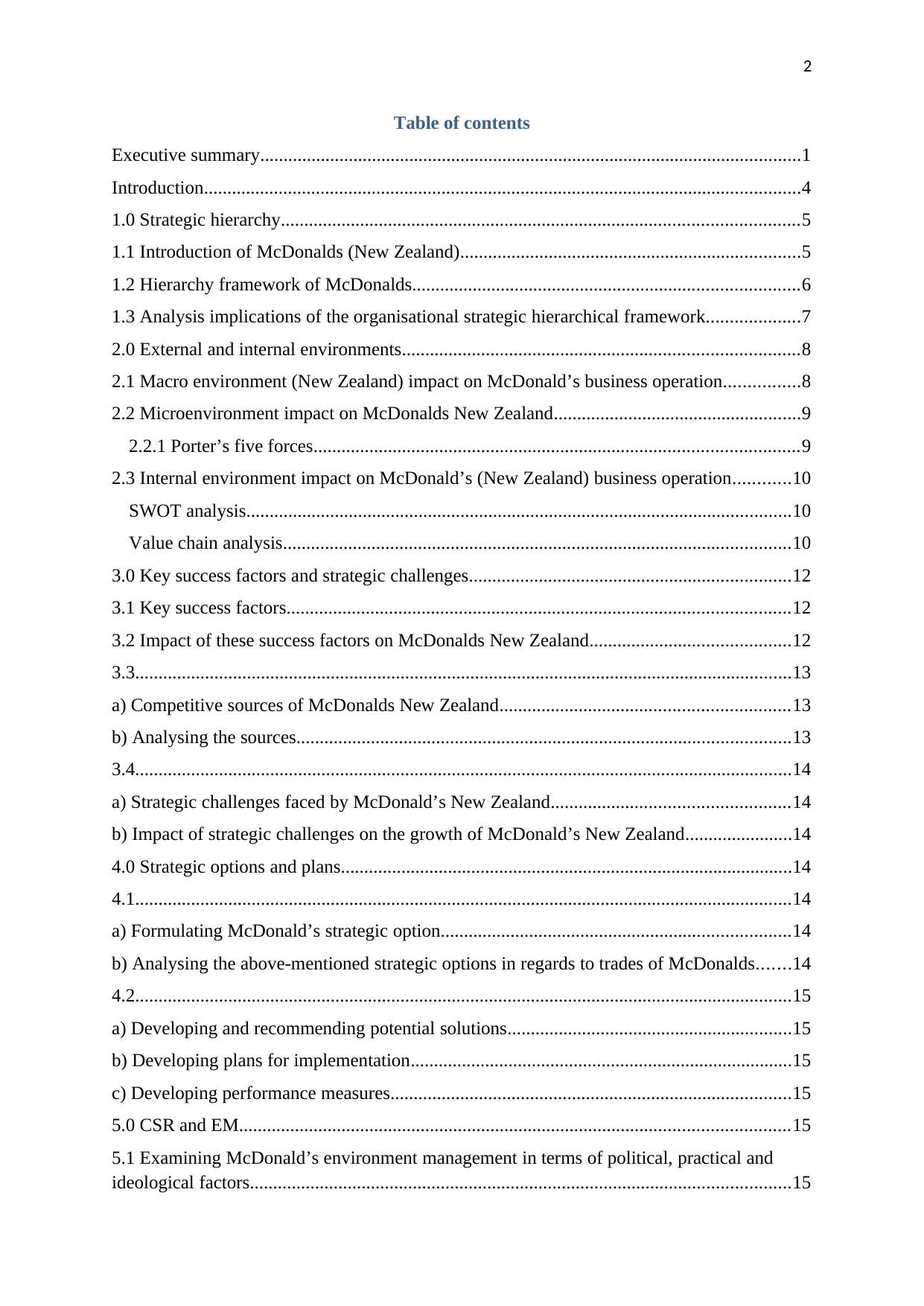
2
Table of contents
Executive summary....................................................................................................................1
Introduction................................................................................................................................4
1.0 Strategic hierarchy...............................................................................................................5
1.1 Introduction of McDonalds (New Zealand).........................................................................5
1.2 Hierarchy framework of McDonalds...................................................................................6
1.3 Analysis implications of the organisational strategic hierarchical framework....................7
2.0 External and internal environments.....................................................................................8
2.1 Macro environment (New Zealand) impact on McDonald’s business operation................8
2.2 Microenvironment impact on McDonalds New Zealand.....................................................9
2.2.1 Porter’s five forces........................................................................................................9
2.3 Internal environment impact on McDonald’s (New Zealand) business operation............10
SWOT analysis.....................................................................................................................10
Value chain analysis.............................................................................................................10
3.0 Key success factors and strategic challenges.....................................................................12
3.1 Key success factors............................................................................................................12
3.2 Impact of these success factors on McDonalds New Zealand...........................................12
3.3.............................................................................................................................................13
a) Competitive sources of McDonalds New Zealand..............................................................13
b) Analysing the sources..........................................................................................................13
3.4.............................................................................................................................................14
a) Strategic challenges faced by McDonald’s New Zealand...................................................14
b) Impact of strategic challenges on the growth of McDonald’s New Zealand.......................14
4.0 Strategic options and plans.................................................................................................14
4.1.............................................................................................................................................14
a) Formulating McDonald’s strategic option...........................................................................14
b) Analysing the above-mentioned strategic options in regards to trades of McDonalds.......14
4.2.............................................................................................................................................15
a) Developing and recommending potential solutions.............................................................15
b) Developing plans for implementation..................................................................................15
c) Developing performance measures......................................................................................15
5.0 CSR and EM......................................................................................................................15
5.1 Examining McDonald’s environment management in terms of political, practical and
ideological factors....................................................................................................................15
Table of contents
Executive summary....................................................................................................................1
Introduction................................................................................................................................4
1.0 Strategic hierarchy...............................................................................................................5
1.1 Introduction of McDonalds (New Zealand).........................................................................5
1.2 Hierarchy framework of McDonalds...................................................................................6
1.3 Analysis implications of the organisational strategic hierarchical framework....................7
2.0 External and internal environments.....................................................................................8
2.1 Macro environment (New Zealand) impact on McDonald’s business operation................8
2.2 Microenvironment impact on McDonalds New Zealand.....................................................9
2.2.1 Porter’s five forces........................................................................................................9
2.3 Internal environment impact on McDonald’s (New Zealand) business operation............10
SWOT analysis.....................................................................................................................10
Value chain analysis.............................................................................................................10
3.0 Key success factors and strategic challenges.....................................................................12
3.1 Key success factors............................................................................................................12
3.2 Impact of these success factors on McDonalds New Zealand...........................................12
3.3.............................................................................................................................................13
a) Competitive sources of McDonalds New Zealand..............................................................13
b) Analysing the sources..........................................................................................................13
3.4.............................................................................................................................................14
a) Strategic challenges faced by McDonald’s New Zealand...................................................14
b) Impact of strategic challenges on the growth of McDonald’s New Zealand.......................14
4.0 Strategic options and plans.................................................................................................14
4.1.............................................................................................................................................14
a) Formulating McDonald’s strategic option...........................................................................14
b) Analysing the above-mentioned strategic options in regards to trades of McDonalds.......14
4.2.............................................................................................................................................15
a) Developing and recommending potential solutions.............................................................15
b) Developing plans for implementation..................................................................................15
c) Developing performance measures......................................................................................15
5.0 CSR and EM......................................................................................................................15
5.1 Examining McDonald’s environment management in terms of political, practical and
ideological factors....................................................................................................................15
⊘ This is a preview!⊘
Do you want full access?
Subscribe today to unlock all pages.

Trusted by 1+ million students worldwide
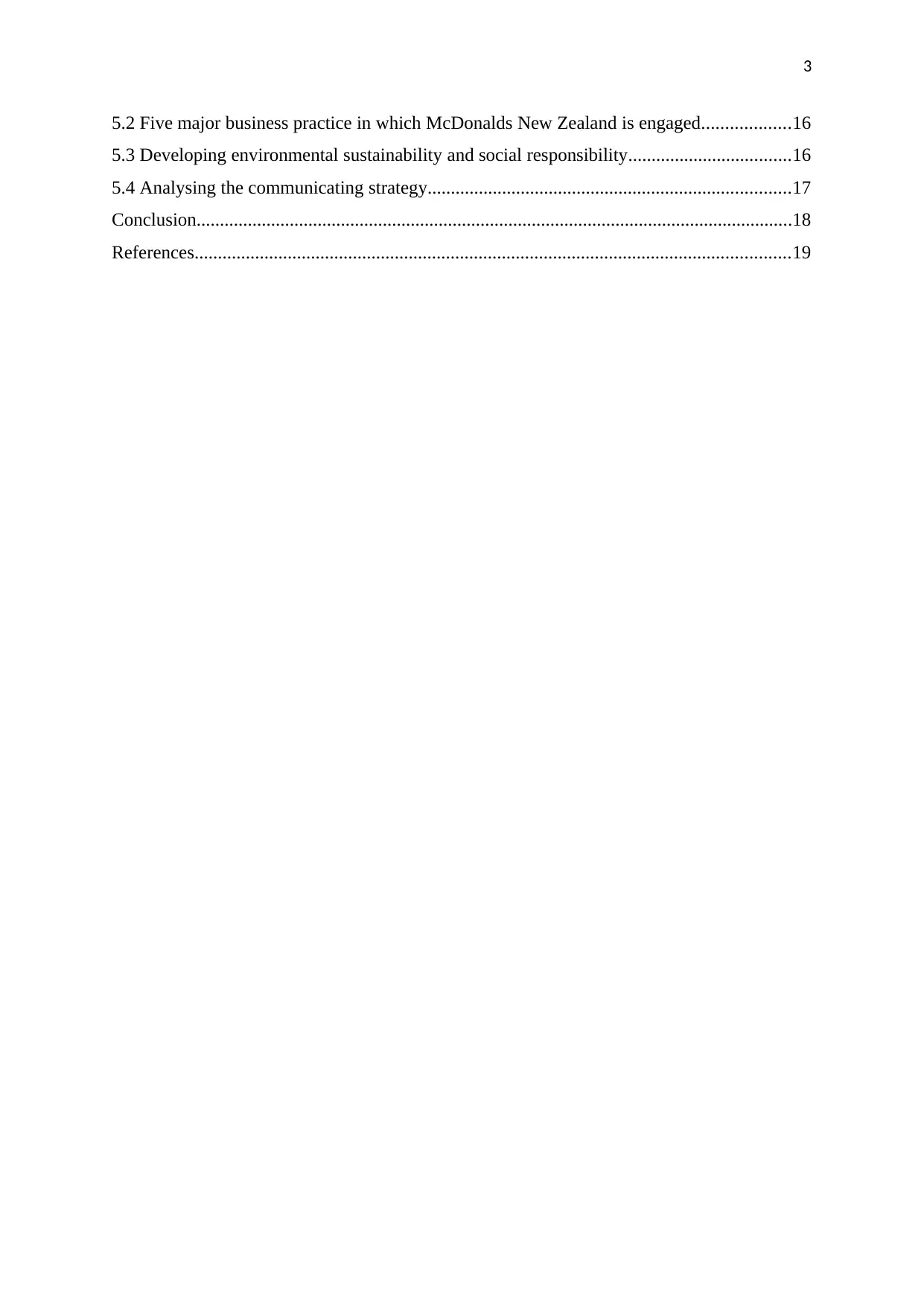
3
5.2 Five major business practice in which McDonalds New Zealand is engaged...................16
5.3 Developing environmental sustainability and social responsibility...................................16
5.4 Analysing the communicating strategy..............................................................................17
Conclusion................................................................................................................................18
References................................................................................................................................19
5.2 Five major business practice in which McDonalds New Zealand is engaged...................16
5.3 Developing environmental sustainability and social responsibility...................................16
5.4 Analysing the communicating strategy..............................................................................17
Conclusion................................................................................................................................18
References................................................................................................................................19
Paraphrase This Document
Need a fresh take? Get an instant paraphrase of this document with our AI Paraphraser
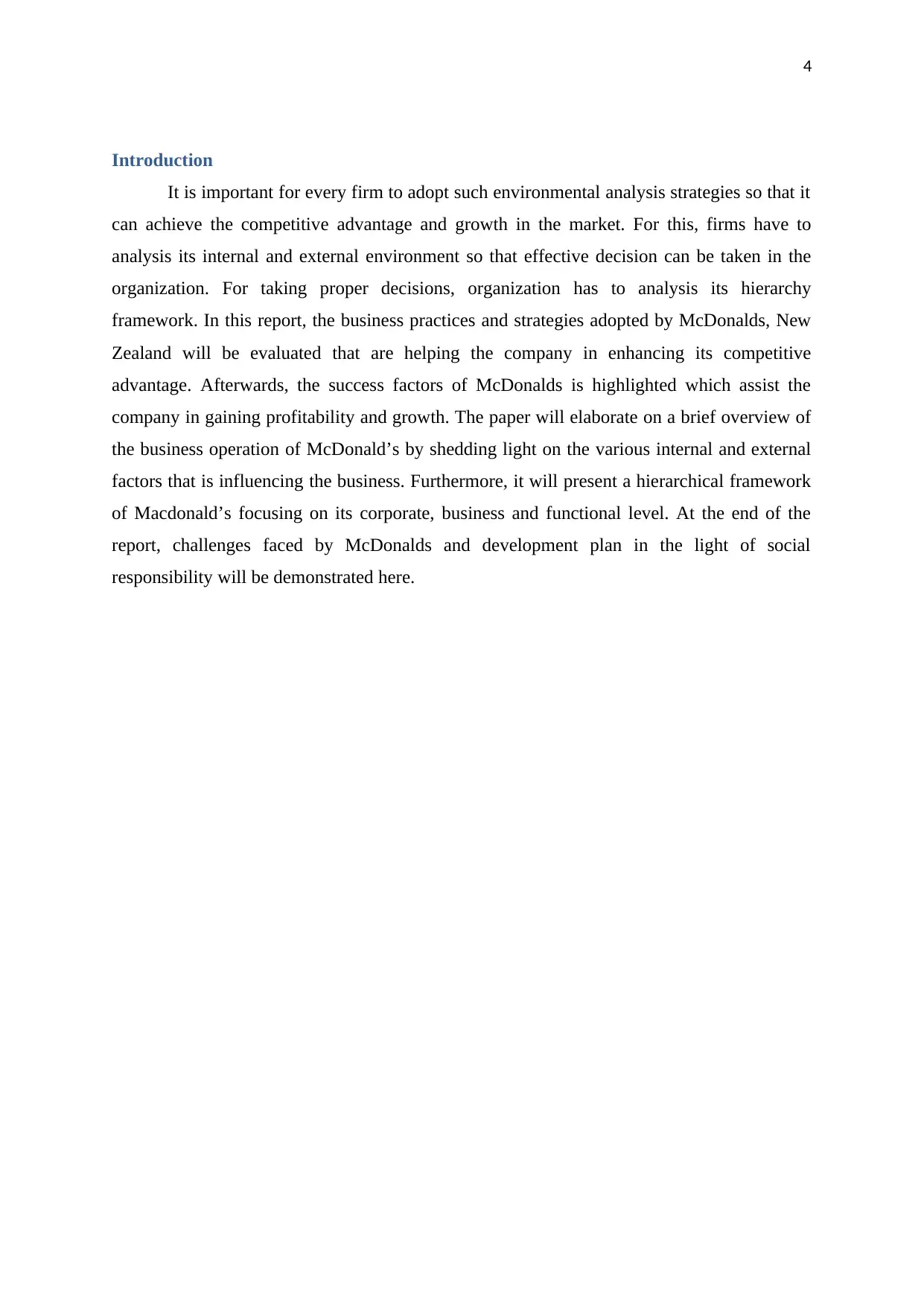
4
Introduction
It is important for every firm to adopt such environmental analysis strategies so that it
can achieve the competitive advantage and growth in the market. For this, firms have to
analysis its internal and external environment so that effective decision can be taken in the
organization. For taking proper decisions, organization has to analysis its hierarchy
framework. In this report, the business practices and strategies adopted by McDonalds, New
Zealand will be evaluated that are helping the company in enhancing its competitive
advantage. Afterwards, the success factors of McDonalds is highlighted which assist the
company in gaining profitability and growth. The paper will elaborate on a brief overview of
the business operation of McDonald’s by shedding light on the various internal and external
factors that is influencing the business. Furthermore, it will present a hierarchical framework
of Macdonald’s focusing on its corporate, business and functional level. At the end of the
report, challenges faced by McDonalds and development plan in the light of social
responsibility will be demonstrated here.
Introduction
It is important for every firm to adopt such environmental analysis strategies so that it
can achieve the competitive advantage and growth in the market. For this, firms have to
analysis its internal and external environment so that effective decision can be taken in the
organization. For taking proper decisions, organization has to analysis its hierarchy
framework. In this report, the business practices and strategies adopted by McDonalds, New
Zealand will be evaluated that are helping the company in enhancing its competitive
advantage. Afterwards, the success factors of McDonalds is highlighted which assist the
company in gaining profitability and growth. The paper will elaborate on a brief overview of
the business operation of McDonald’s by shedding light on the various internal and external
factors that is influencing the business. Furthermore, it will present a hierarchical framework
of Macdonald’s focusing on its corporate, business and functional level. At the end of the
report, challenges faced by McDonalds and development plan in the light of social
responsibility will be demonstrated here.
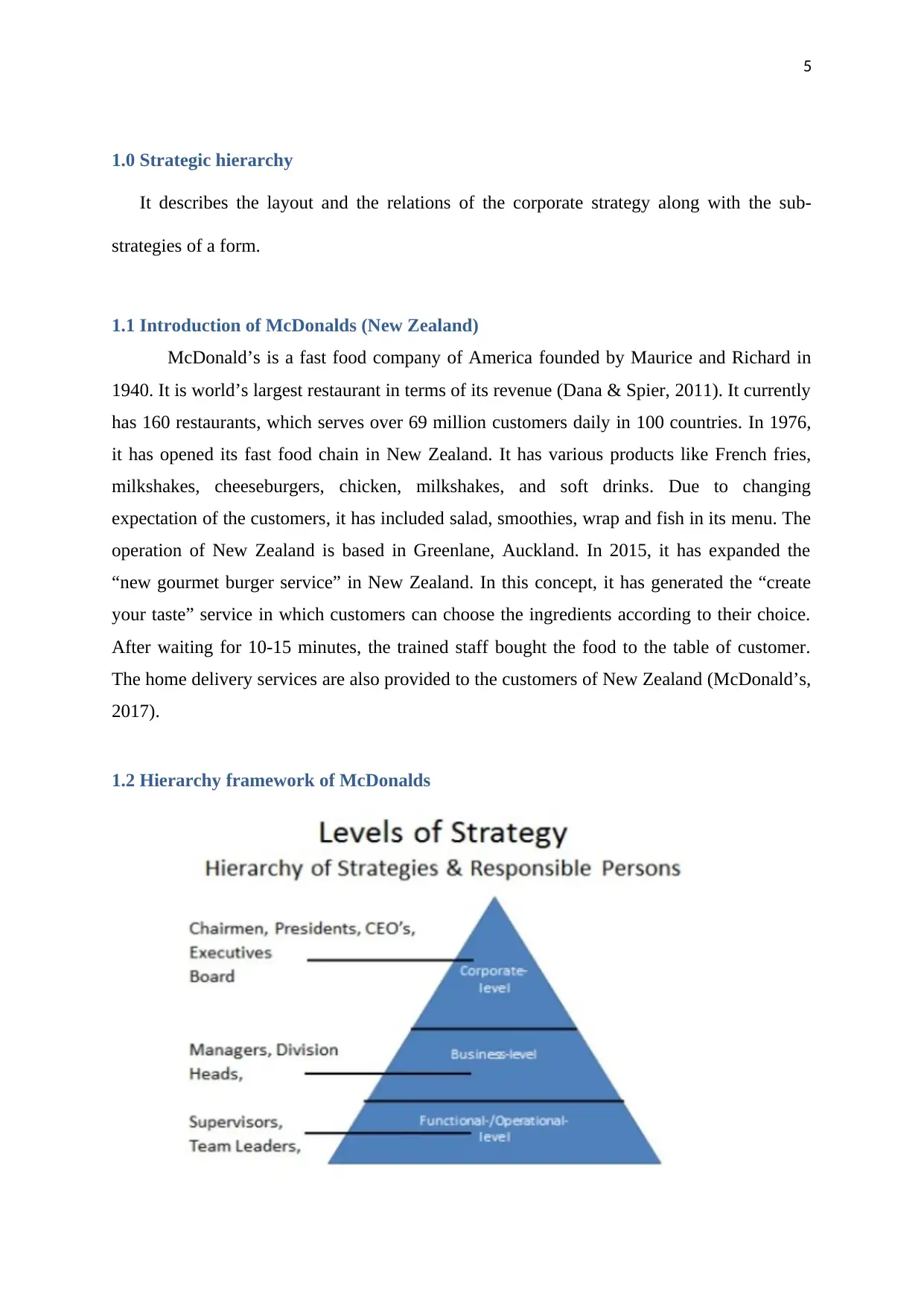
5
1.0 Strategic hierarchy
It describes the layout and the relations of the corporate strategy along with the sub-
strategies of a form.
1.1 Introduction of McDonalds (New Zealand)
McDonald’s is a fast food company of America founded by Maurice and Richard in
1940. It is world’s largest restaurant in terms of its revenue (Dana & Spier, 2011). It currently
has 160 restaurants, which serves over 69 million customers daily in 100 countries. In 1976,
it has opened its fast food chain in New Zealand. It has various products like French fries,
milkshakes, cheeseburgers, chicken, milkshakes, and soft drinks. Due to changing
expectation of the customers, it has included salad, smoothies, wrap and fish in its menu. The
operation of New Zealand is based in Greenlane, Auckland. In 2015, it has expanded the
“new gourmet burger service” in New Zealand. In this concept, it has generated the “create
your taste” service in which customers can choose the ingredients according to their choice.
After waiting for 10-15 minutes, the trained staff bought the food to the table of customer.
The home delivery services are also provided to the customers of New Zealand (McDonald’s,
2017).
1.2 Hierarchy framework of McDonalds
1.0 Strategic hierarchy
It describes the layout and the relations of the corporate strategy along with the sub-
strategies of a form.
1.1 Introduction of McDonalds (New Zealand)
McDonald’s is a fast food company of America founded by Maurice and Richard in
1940. It is world’s largest restaurant in terms of its revenue (Dana & Spier, 2011). It currently
has 160 restaurants, which serves over 69 million customers daily in 100 countries. In 1976,
it has opened its fast food chain in New Zealand. It has various products like French fries,
milkshakes, cheeseburgers, chicken, milkshakes, and soft drinks. Due to changing
expectation of the customers, it has included salad, smoothies, wrap and fish in its menu. The
operation of New Zealand is based in Greenlane, Auckland. In 2015, it has expanded the
“new gourmet burger service” in New Zealand. In this concept, it has generated the “create
your taste” service in which customers can choose the ingredients according to their choice.
After waiting for 10-15 minutes, the trained staff bought the food to the table of customer.
The home delivery services are also provided to the customers of New Zealand (McDonald’s,
2017).
1.2 Hierarchy framework of McDonalds
⊘ This is a preview!⊘
Do you want full access?
Subscribe today to unlock all pages.

Trusted by 1+ million students worldwide
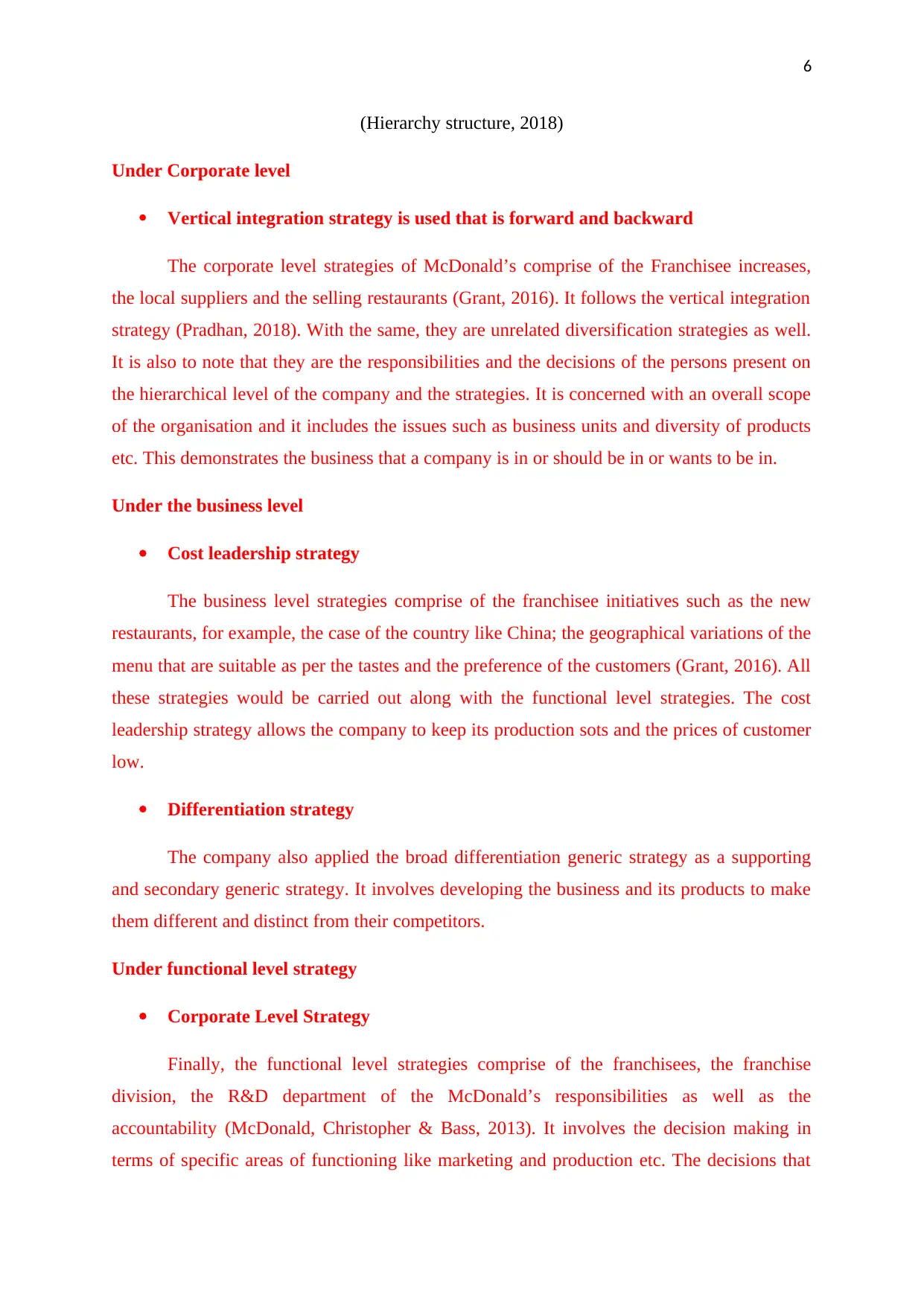
6
(Hierarchy structure, 2018)
Under Corporate level
Vertical integration strategy is used that is forward and backward
The corporate level strategies of McDonald’s comprise of the Franchisee increases,
the local suppliers and the selling restaurants (Grant, 2016). It follows the vertical integration
strategy (Pradhan, 2018). With the same, they are unrelated diversification strategies as well.
It is also to note that they are the responsibilities and the decisions of the persons present on
the hierarchical level of the company and the strategies. It is concerned with an overall scope
of the organisation and it includes the issues such as business units and diversity of products
etc. This demonstrates the business that a company is in or should be in or wants to be in.
Under the business level
Cost leadership strategy
The business level strategies comprise of the franchisee initiatives such as the new
restaurants, for example, the case of the country like China; the geographical variations of the
menu that are suitable as per the tastes and the preference of the customers (Grant, 2016). All
these strategies would be carried out along with the functional level strategies. The cost
leadership strategy allows the company to keep its production sots and the prices of customer
low.
Differentiation strategy
The company also applied the broad differentiation generic strategy as a supporting
and secondary generic strategy. It involves developing the business and its products to make
them different and distinct from their competitors.
Under functional level strategy
Corporate Level Strategy
Finally, the functional level strategies comprise of the franchisees, the franchise
division, the R&D department of the McDonald’s responsibilities as well as the
accountability (McDonald, Christopher & Bass, 2013). It involves the decision making in
terms of specific areas of functioning like marketing and production etc. The decisions that
(Hierarchy structure, 2018)
Under Corporate level
Vertical integration strategy is used that is forward and backward
The corporate level strategies of McDonald’s comprise of the Franchisee increases,
the local suppliers and the selling restaurants (Grant, 2016). It follows the vertical integration
strategy (Pradhan, 2018). With the same, they are unrelated diversification strategies as well.
It is also to note that they are the responsibilities and the decisions of the persons present on
the hierarchical level of the company and the strategies. It is concerned with an overall scope
of the organisation and it includes the issues such as business units and diversity of products
etc. This demonstrates the business that a company is in or should be in or wants to be in.
Under the business level
Cost leadership strategy
The business level strategies comprise of the franchisee initiatives such as the new
restaurants, for example, the case of the country like China; the geographical variations of the
menu that are suitable as per the tastes and the preference of the customers (Grant, 2016). All
these strategies would be carried out along with the functional level strategies. The cost
leadership strategy allows the company to keep its production sots and the prices of customer
low.
Differentiation strategy
The company also applied the broad differentiation generic strategy as a supporting
and secondary generic strategy. It involves developing the business and its products to make
them different and distinct from their competitors.
Under functional level strategy
Corporate Level Strategy
Finally, the functional level strategies comprise of the franchisees, the franchise
division, the R&D department of the McDonald’s responsibilities as well as the
accountability (McDonald, Christopher & Bass, 2013). It involves the decision making in
terms of specific areas of functioning like marketing and production etc. The decisions that
Paraphrase This Document
Need a fresh take? Get an instant paraphrase of this document with our AI Paraphraser
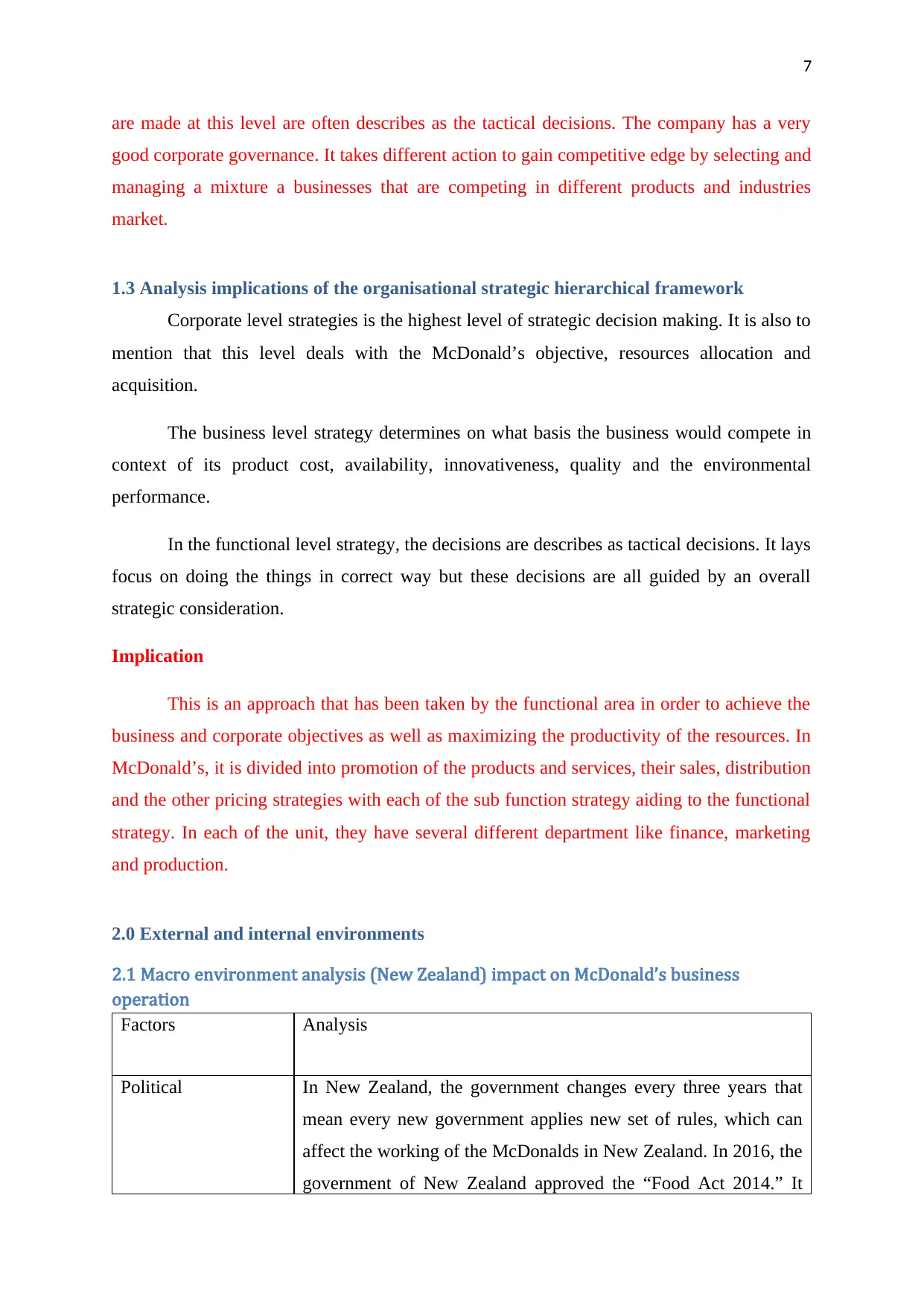
7
are made at this level are often describes as the tactical decisions. The company has a very
good corporate governance. It takes different action to gain competitive edge by selecting and
managing a mixture a businesses that are competing in different products and industries
market.
1.3 Analysis implications of the organisational strategic hierarchical framework
Corporate level strategies is the highest level of strategic decision making. It is also to
mention that this level deals with the McDonald’s objective, resources allocation and
acquisition.
The business level strategy determines on what basis the business would compete in
context of its product cost, availability, innovativeness, quality and the environmental
performance.
In the functional level strategy, the decisions are describes as tactical decisions. It lays
focus on doing the things in correct way but these decisions are all guided by an overall
strategic consideration.
Implication
This is an approach that has been taken by the functional area in order to achieve the
business and corporate objectives as well as maximizing the productivity of the resources. In
McDonald’s, it is divided into promotion of the products and services, their sales, distribution
and the other pricing strategies with each of the sub function strategy aiding to the functional
strategy. In each of the unit, they have several different department like finance, marketing
and production.
2.0 External and internal environments
2.1 Macro environment analysis (New Zealand) impact on McDonald’s business
operation
Factors Analysis
Political In New Zealand, the government changes every three years that
mean every new government applies new set of rules, which can
affect the working of the McDonalds in New Zealand. In 2016, the
government of New Zealand approved the “Food Act 2014.” It
are made at this level are often describes as the tactical decisions. The company has a very
good corporate governance. It takes different action to gain competitive edge by selecting and
managing a mixture a businesses that are competing in different products and industries
market.
1.3 Analysis implications of the organisational strategic hierarchical framework
Corporate level strategies is the highest level of strategic decision making. It is also to
mention that this level deals with the McDonald’s objective, resources allocation and
acquisition.
The business level strategy determines on what basis the business would compete in
context of its product cost, availability, innovativeness, quality and the environmental
performance.
In the functional level strategy, the decisions are describes as tactical decisions. It lays
focus on doing the things in correct way but these decisions are all guided by an overall
strategic consideration.
Implication
This is an approach that has been taken by the functional area in order to achieve the
business and corporate objectives as well as maximizing the productivity of the resources. In
McDonald’s, it is divided into promotion of the products and services, their sales, distribution
and the other pricing strategies with each of the sub function strategy aiding to the functional
strategy. In each of the unit, they have several different department like finance, marketing
and production.
2.0 External and internal environments
2.1 Macro environment analysis (New Zealand) impact on McDonald’s business
operation
Factors Analysis
Political In New Zealand, the government changes every three years that
mean every new government applies new set of rules, which can
affect the working of the McDonalds in New Zealand. In 2016, the
government of New Zealand approved the “Food Act 2014.” It
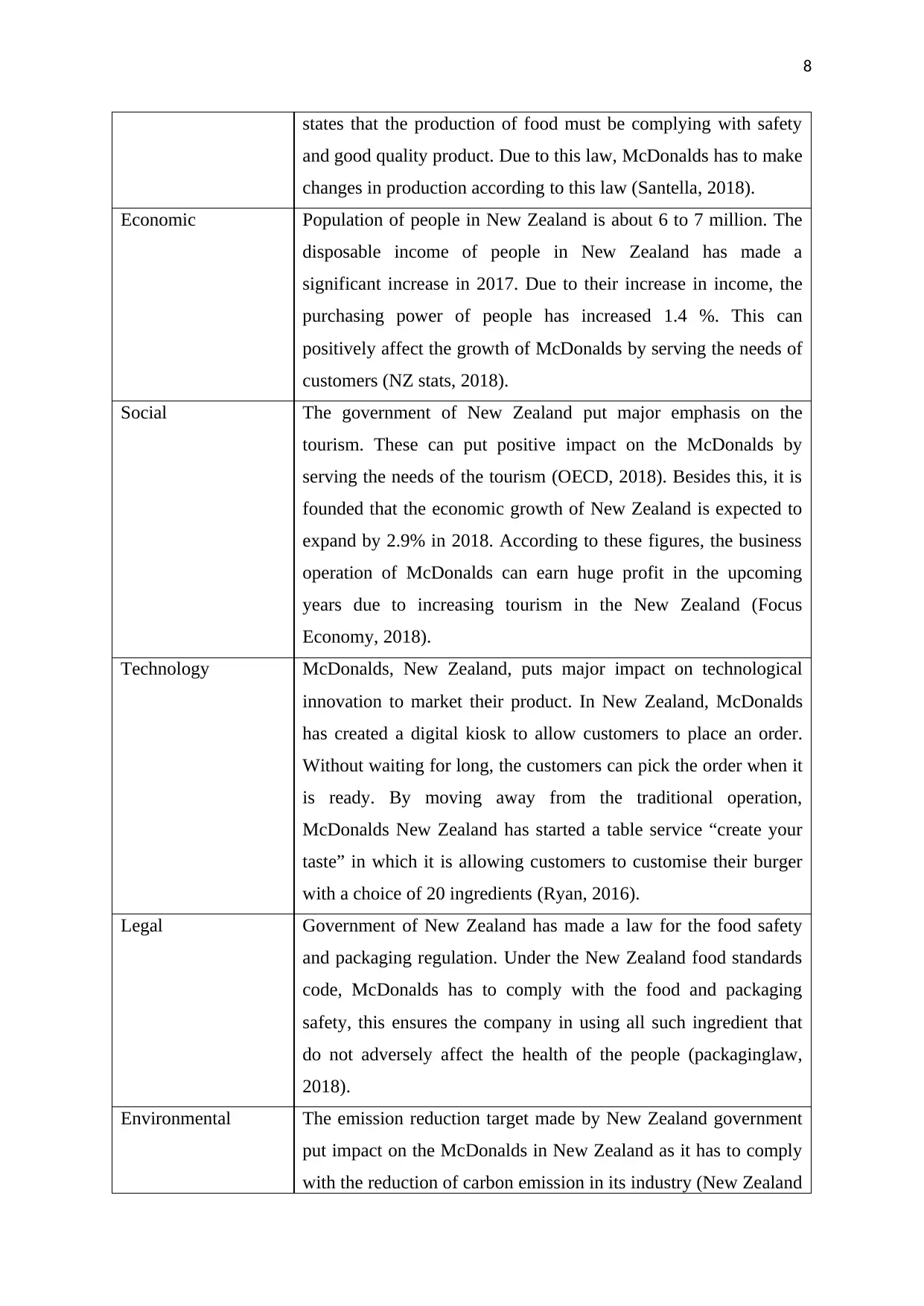
8
states that the production of food must be complying with safety
and good quality product. Due to this law, McDonalds has to make
changes in production according to this law (Santella, 2018).
Economic Population of people in New Zealand is about 6 to 7 million. The
disposable income of people in New Zealand has made a
significant increase in 2017. Due to their increase in income, the
purchasing power of people has increased 1.4 %. This can
positively affect the growth of McDonalds by serving the needs of
customers (NZ stats, 2018).
Social The government of New Zealand put major emphasis on the
tourism. These can put positive impact on the McDonalds by
serving the needs of the tourism (OECD, 2018). Besides this, it is
founded that the economic growth of New Zealand is expected to
expand by 2.9% in 2018. According to these figures, the business
operation of McDonalds can earn huge profit in the upcoming
years due to increasing tourism in the New Zealand (Focus
Economy, 2018).
Technology McDonalds, New Zealand, puts major impact on technological
innovation to market their product. In New Zealand, McDonalds
has created a digital kiosk to allow customers to place an order.
Without waiting for long, the customers can pick the order when it
is ready. By moving away from the traditional operation,
McDonalds New Zealand has started a table service “create your
taste” in which it is allowing customers to customise their burger
with a choice of 20 ingredients (Ryan, 2016).
Legal Government of New Zealand has made a law for the food safety
and packaging regulation. Under the New Zealand food standards
code, McDonalds has to comply with the food and packaging
safety, this ensures the company in using all such ingredient that
do not adversely affect the health of the people (packaginglaw,
2018).
Environmental The emission reduction target made by New Zealand government
put impact on the McDonalds in New Zealand as it has to comply
with the reduction of carbon emission in its industry (New Zealand
states that the production of food must be complying with safety
and good quality product. Due to this law, McDonalds has to make
changes in production according to this law (Santella, 2018).
Economic Population of people in New Zealand is about 6 to 7 million. The
disposable income of people in New Zealand has made a
significant increase in 2017. Due to their increase in income, the
purchasing power of people has increased 1.4 %. This can
positively affect the growth of McDonalds by serving the needs of
customers (NZ stats, 2018).
Social The government of New Zealand put major emphasis on the
tourism. These can put positive impact on the McDonalds by
serving the needs of the tourism (OECD, 2018). Besides this, it is
founded that the economic growth of New Zealand is expected to
expand by 2.9% in 2018. According to these figures, the business
operation of McDonalds can earn huge profit in the upcoming
years due to increasing tourism in the New Zealand (Focus
Economy, 2018).
Technology McDonalds, New Zealand, puts major impact on technological
innovation to market their product. In New Zealand, McDonalds
has created a digital kiosk to allow customers to place an order.
Without waiting for long, the customers can pick the order when it
is ready. By moving away from the traditional operation,
McDonalds New Zealand has started a table service “create your
taste” in which it is allowing customers to customise their burger
with a choice of 20 ingredients (Ryan, 2016).
Legal Government of New Zealand has made a law for the food safety
and packaging regulation. Under the New Zealand food standards
code, McDonalds has to comply with the food and packaging
safety, this ensures the company in using all such ingredient that
do not adversely affect the health of the people (packaginglaw,
2018).
Environmental The emission reduction target made by New Zealand government
put impact on the McDonalds in New Zealand as it has to comply
with the reduction of carbon emission in its industry (New Zealand
⊘ This is a preview!⊘
Do you want full access?
Subscribe today to unlock all pages.

Trusted by 1+ million students worldwide
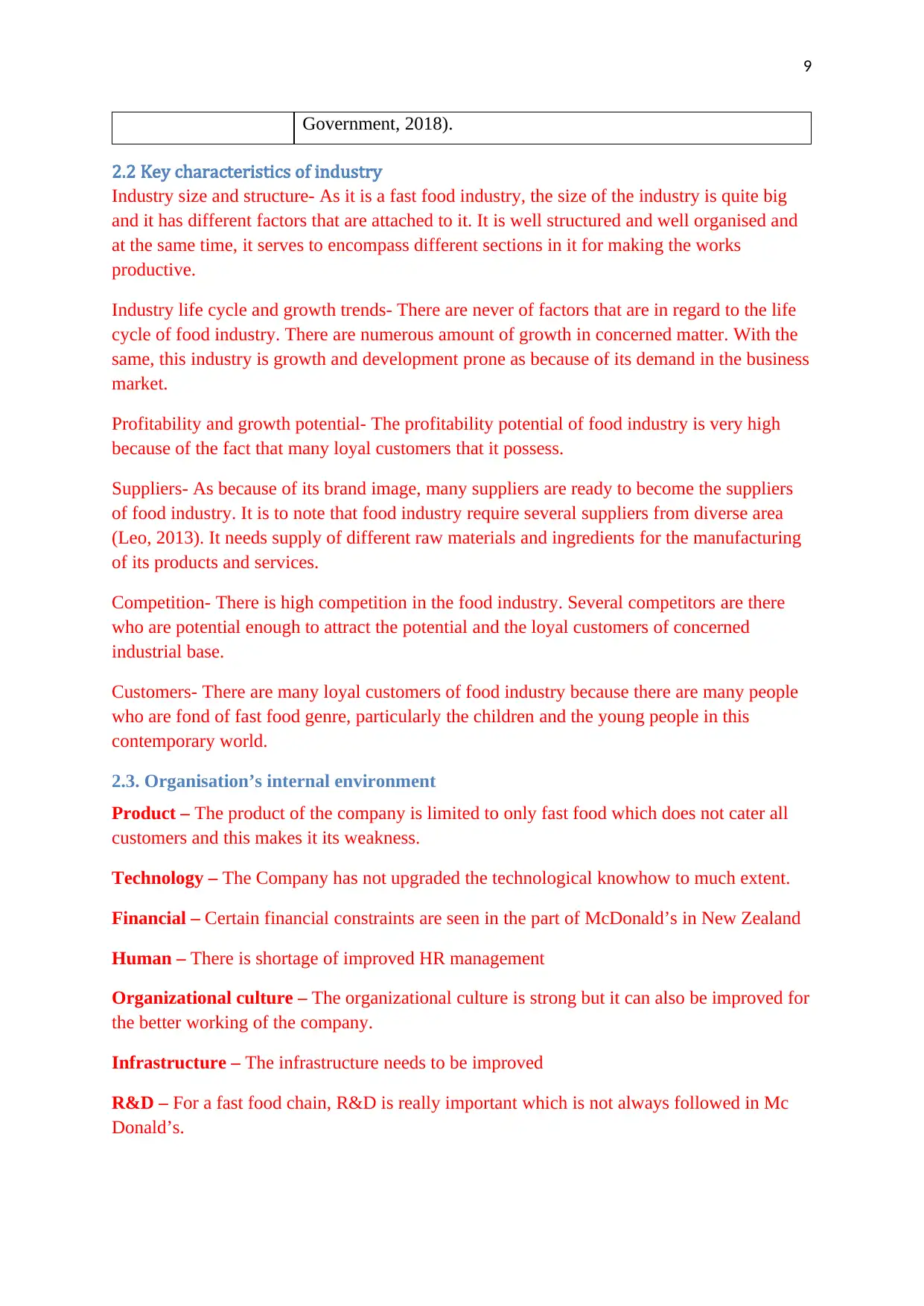
9
Government, 2018).
2.2 Key characteristics of industry
Industry size and structure- As it is a fast food industry, the size of the industry is quite big
and it has different factors that are attached to it. It is well structured and well organised and
at the same time, it serves to encompass different sections in it for making the works
productive.
Industry life cycle and growth trends- There are never of factors that are in regard to the life
cycle of food industry. There are numerous amount of growth in concerned matter. With the
same, this industry is growth and development prone as because of its demand in the business
market.
Profitability and growth potential- The profitability potential of food industry is very high
because of the fact that many loyal customers that it possess.
Suppliers- As because of its brand image, many suppliers are ready to become the suppliers
of food industry. It is to note that food industry require several suppliers from diverse area
(Leo, 2013). It needs supply of different raw materials and ingredients for the manufacturing
of its products and services.
Competition- There is high competition in the food industry. Several competitors are there
who are potential enough to attract the potential and the loyal customers of concerned
industrial base.
Customers- There are many loyal customers of food industry because there are many people
who are fond of fast food genre, particularly the children and the young people in this
contemporary world.
2.3. Organisation’s internal environment
Product – The product of the company is limited to only fast food which does not cater all
customers and this makes it its weakness.
Technology – The Company has not upgraded the technological knowhow to much extent.
Financial – Certain financial constraints are seen in the part of McDonald’s in New Zealand
Human – There is shortage of improved HR management
Organizational culture – The organizational culture is strong but it can also be improved for
the better working of the company.
Infrastructure – The infrastructure needs to be improved
R&D – For a fast food chain, R&D is really important which is not always followed in Mc
Donald’s.
Government, 2018).
2.2 Key characteristics of industry
Industry size and structure- As it is a fast food industry, the size of the industry is quite big
and it has different factors that are attached to it. It is well structured and well organised and
at the same time, it serves to encompass different sections in it for making the works
productive.
Industry life cycle and growth trends- There are never of factors that are in regard to the life
cycle of food industry. There are numerous amount of growth in concerned matter. With the
same, this industry is growth and development prone as because of its demand in the business
market.
Profitability and growth potential- The profitability potential of food industry is very high
because of the fact that many loyal customers that it possess.
Suppliers- As because of its brand image, many suppliers are ready to become the suppliers
of food industry. It is to note that food industry require several suppliers from diverse area
(Leo, 2013). It needs supply of different raw materials and ingredients for the manufacturing
of its products and services.
Competition- There is high competition in the food industry. Several competitors are there
who are potential enough to attract the potential and the loyal customers of concerned
industrial base.
Customers- There are many loyal customers of food industry because there are many people
who are fond of fast food genre, particularly the children and the young people in this
contemporary world.
2.3. Organisation’s internal environment
Product – The product of the company is limited to only fast food which does not cater all
customers and this makes it its weakness.
Technology – The Company has not upgraded the technological knowhow to much extent.
Financial – Certain financial constraints are seen in the part of McDonald’s in New Zealand
Human – There is shortage of improved HR management
Organizational culture – The organizational culture is strong but it can also be improved for
the better working of the company.
Infrastructure – The infrastructure needs to be improved
R&D – For a fast food chain, R&D is really important which is not always followed in Mc
Donald’s.
Paraphrase This Document
Need a fresh take? Get an instant paraphrase of this document with our AI Paraphraser
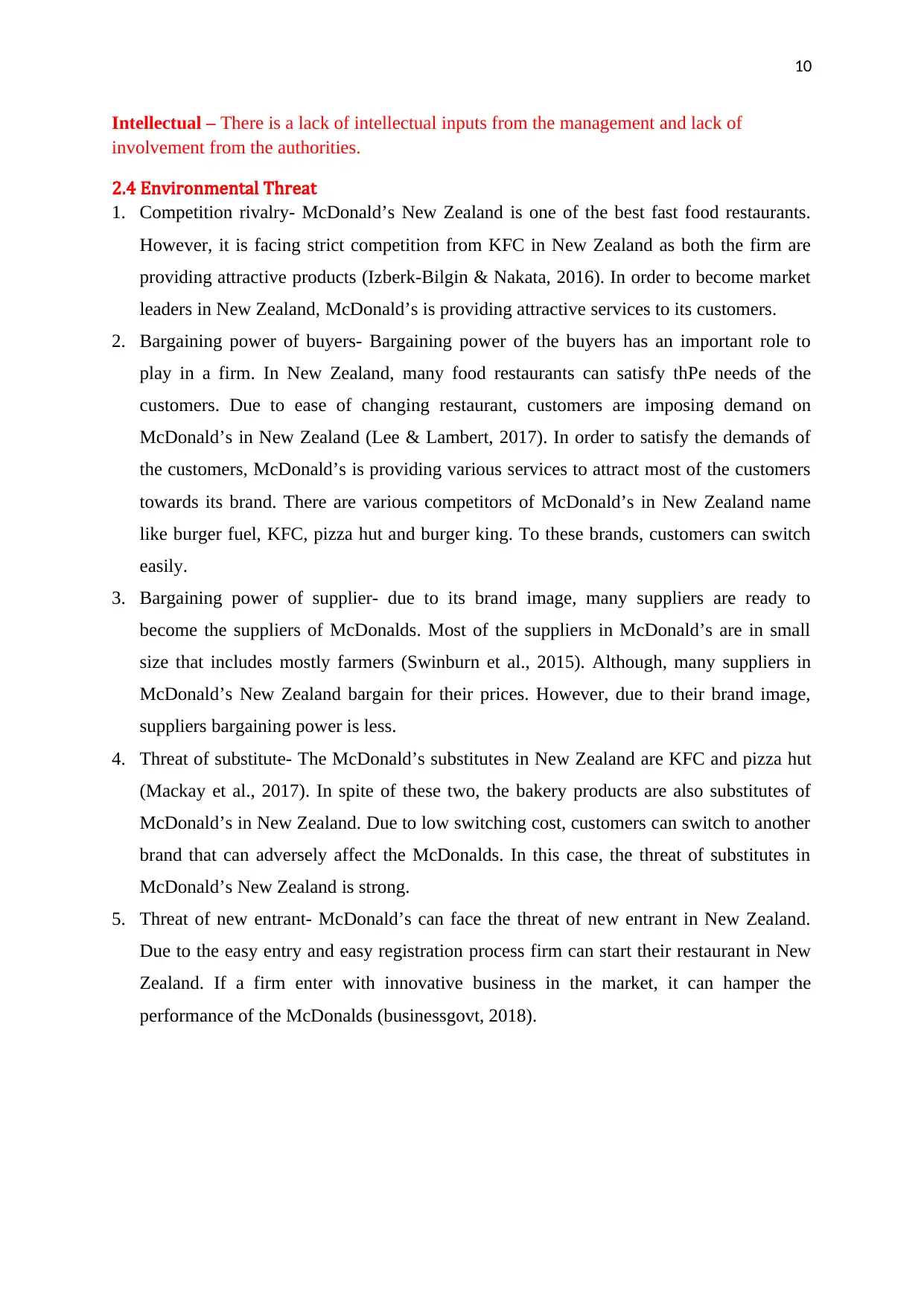
10
Intellectual – There is a lack of intellectual inputs from the management and lack of
involvement from the authorities.
2.4 Environmental Threat
1. Competition rivalry- McDonald’s New Zealand is one of the best fast food restaurants.
However, it is facing strict competition from KFC in New Zealand as both the firm are
providing attractive products (Izberk-Bilgin & Nakata, 2016). In order to become market
leaders in New Zealand, McDonald’s is providing attractive services to its customers.
2. Bargaining power of buyers- Bargaining power of the buyers has an important role to
play in a firm. In New Zealand, many food restaurants can satisfy thPe needs of the
customers. Due to ease of changing restaurant, customers are imposing demand on
McDonald’s in New Zealand (Lee & Lambert, 2017). In order to satisfy the demands of
the customers, McDonald’s is providing various services to attract most of the customers
towards its brand. There are various competitors of McDonald’s in New Zealand name
like burger fuel, KFC, pizza hut and burger king. To these brands, customers can switch
easily.
3. Bargaining power of supplier- due to its brand image, many suppliers are ready to
become the suppliers of McDonalds. Most of the suppliers in McDonald’s are in small
size that includes mostly farmers (Swinburn et al., 2015). Although, many suppliers in
McDonald’s New Zealand bargain for their prices. However, due to their brand image,
suppliers bargaining power is less.
4. Threat of substitute- The McDonald’s substitutes in New Zealand are KFC and pizza hut
(Mackay et al., 2017). In spite of these two, the bakery products are also substitutes of
McDonald’s in New Zealand. Due to low switching cost, customers can switch to another
brand that can adversely affect the McDonalds. In this case, the threat of substitutes in
McDonald’s New Zealand is strong.
5. Threat of new entrant- McDonald’s can face the threat of new entrant in New Zealand.
Due to the easy entry and easy registration process firm can start their restaurant in New
Zealand. If a firm enter with innovative business in the market, it can hamper the
performance of the McDonalds (businessgovt, 2018).
Intellectual – There is a lack of intellectual inputs from the management and lack of
involvement from the authorities.
2.4 Environmental Threat
1. Competition rivalry- McDonald’s New Zealand is one of the best fast food restaurants.
However, it is facing strict competition from KFC in New Zealand as both the firm are
providing attractive products (Izberk-Bilgin & Nakata, 2016). In order to become market
leaders in New Zealand, McDonald’s is providing attractive services to its customers.
2. Bargaining power of buyers- Bargaining power of the buyers has an important role to
play in a firm. In New Zealand, many food restaurants can satisfy thPe needs of the
customers. Due to ease of changing restaurant, customers are imposing demand on
McDonald’s in New Zealand (Lee & Lambert, 2017). In order to satisfy the demands of
the customers, McDonald’s is providing various services to attract most of the customers
towards its brand. There are various competitors of McDonald’s in New Zealand name
like burger fuel, KFC, pizza hut and burger king. To these brands, customers can switch
easily.
3. Bargaining power of supplier- due to its brand image, many suppliers are ready to
become the suppliers of McDonalds. Most of the suppliers in McDonald’s are in small
size that includes mostly farmers (Swinburn et al., 2015). Although, many suppliers in
McDonald’s New Zealand bargain for their prices. However, due to their brand image,
suppliers bargaining power is less.
4. Threat of substitute- The McDonald’s substitutes in New Zealand are KFC and pizza hut
(Mackay et al., 2017). In spite of these two, the bakery products are also substitutes of
McDonald’s in New Zealand. Due to low switching cost, customers can switch to another
brand that can adversely affect the McDonalds. In this case, the threat of substitutes in
McDonald’s New Zealand is strong.
5. Threat of new entrant- McDonald’s can face the threat of new entrant in New Zealand.
Due to the easy entry and easy registration process firm can start their restaurant in New
Zealand. If a firm enter with innovative business in the market, it can hamper the
performance of the McDonalds (businessgovt, 2018).
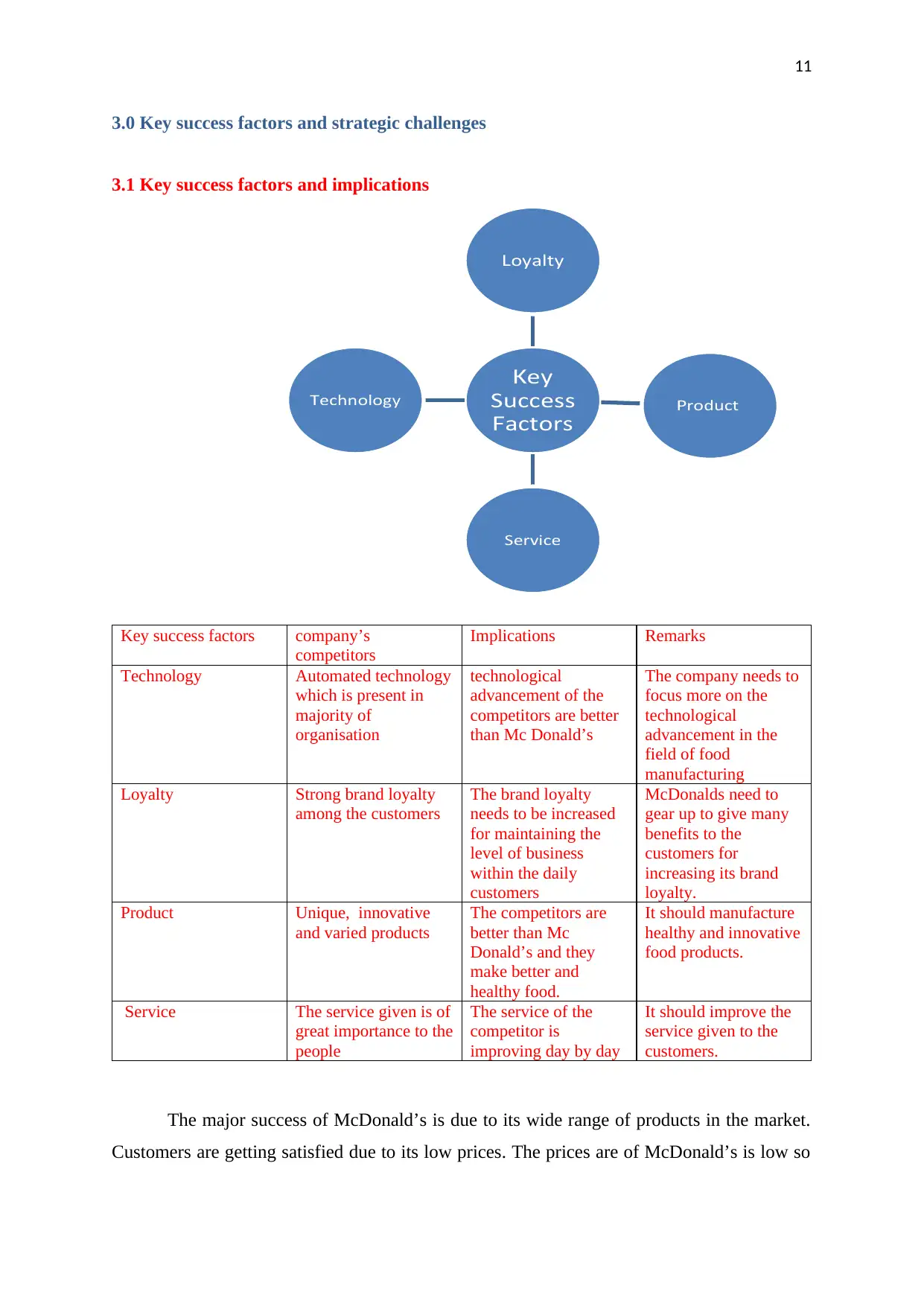
11
3.0 Key success factors and strategic challenges
3.1 Key success factors and implications
Key success factors company’s
competitors
Implications Remarks
Technology Automated technology
which is present in
majority of
organisation
technological
advancement of the
competitors are better
than Mc Donald’s
The company needs to
focus more on the
technological
advancement in the
field of food
manufacturing
Loyalty Strong brand loyalty
among the customers
The brand loyalty
needs to be increased
for maintaining the
level of business
within the daily
customers
McDonalds need to
gear up to give many
benefits to the
customers for
increasing its brand
loyalty.
Product Unique, innovative
and varied products
The competitors are
better than Mc
Donald’s and they
make better and
healthy food.
It should manufacture
healthy and innovative
food products.
Service The service given is of
great importance to the
people
The service of the
competitor is
improving day by day
It should improve the
service given to the
customers.
The major success of McDonald’s is due to its wide range of products in the market.
Customers are getting satisfied due to its low prices. The prices are of McDonald’s is low so
eyK
Success
actorsF
oyaltyL
roductP
Service
echnologyT
3.0 Key success factors and strategic challenges
3.1 Key success factors and implications
Key success factors company’s
competitors
Implications Remarks
Technology Automated technology
which is present in
majority of
organisation
technological
advancement of the
competitors are better
than Mc Donald’s
The company needs to
focus more on the
technological
advancement in the
field of food
manufacturing
Loyalty Strong brand loyalty
among the customers
The brand loyalty
needs to be increased
for maintaining the
level of business
within the daily
customers
McDonalds need to
gear up to give many
benefits to the
customers for
increasing its brand
loyalty.
Product Unique, innovative
and varied products
The competitors are
better than Mc
Donald’s and they
make better and
healthy food.
It should manufacture
healthy and innovative
food products.
Service The service given is of
great importance to the
people
The service of the
competitor is
improving day by day
It should improve the
service given to the
customers.
The major success of McDonald’s is due to its wide range of products in the market.
Customers are getting satisfied due to its low prices. The prices are of McDonald’s is low so
eyK
Success
actorsF
oyaltyL
roductP
Service
echnologyT
⊘ This is a preview!⊘
Do you want full access?
Subscribe today to unlock all pages.

Trusted by 1+ million students worldwide
1 out of 24
Related Documents
Your All-in-One AI-Powered Toolkit for Academic Success.
+13062052269
info@desklib.com
Available 24*7 on WhatsApp / Email
![[object Object]](/_next/static/media/star-bottom.7253800d.svg)
Unlock your academic potential
Copyright © 2020–2025 A2Z Services. All Rights Reserved. Developed and managed by ZUCOL.





